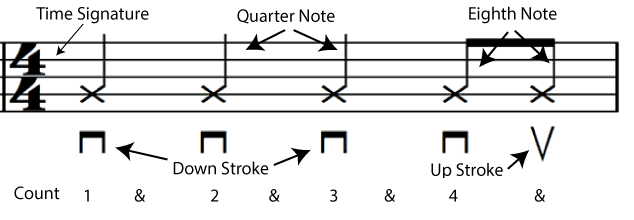Many guitar teachers relate the story of the student that comes to them saying 'I learnt over a hundred guitar chords but I can't seem to make music.' After a very short listen the reason is generally obvious - the rhythmic feel is not there. A truly great rhythm player has developed that great rhythmic feel using many - often very subtle – techniques developed through years of playing experience.
This lesson will get you started on this road by allowing you to have heaps of fun learning and playing your favorite songs.
Let’s get started:
We will try not to bore you with unnecessary stuff just the basics to get you on your way.
Read through the next paragraph and then watch the video lesson that will reinforce these important fundamentals for you.

The time signature in our example therefore suggests that each measure should equal the value of four quarter notes.
Down Stroke
The string is struck with a downward motion of the pick.
Up Stroke
The string is struck with an upward motion of the pick.
Points of interest to watch while viewing the video:
The right hand acts as a type of metronome when playing a continuous eight-note pattern.
Even though some of the down up movements don’t require the strings to be struck - the right hand continues with its eight-note pattern - effectively keeping the time.
Down strokes will be on the beat. For example they fall on the 1 2 3 4.
Up strokes will be off beat. They are played as the picking hand returns for the next down beat.
SHARE THIS PAGE!